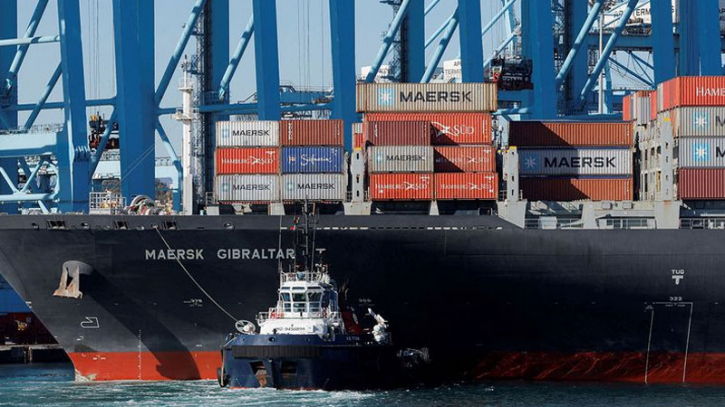Mid-East businesses start to feel cost of Red Sea crisis

Businesses in the Gulf countries including the United Arab Emirates are preparing for sharp increases in their shipment costs to and from Europe as the Red Sea crisis keeps simmering.
So far, container rates have held fairly steady on this extremely vital shipping lane, which effectively connects Europe to Asia and vice versa. What has increased are the marine insurance rates that exporters/importers here have to shell out on their European deliveries.
But if the Red Sea crisis deepens, then the prospect of container rates for longer holding steady will be slim, shipping industry sources in the UAE say.
“Shipping rates could get higher by $300 as a GRI or ‘General Rate Increase’, said Haris Shaikh, Gallop Shipping.
“This would be the amount by which ocean carriers increase their base rates across specific lines, usually as a result of increased demand for containers.
“But in the wake of the Red Sea crisis, the rate increases have not yet been confirmed yet. The confirmed bookings are currently on hold and the GRI of $300 per TEU (20-foot equivalent unit, which is the measure for a container) is anticipated."
Equally, some UAE businesses are worried that any extended crisis related to the Red Sea will lead to longer shipment times – or even outright delays. Also, “The cost of shipping will move up as more vessels start using UAE ports for transhipments,” said Rosh Manoli, Vice-President for Freight Forwarding at Consolidated Shipping Services.
“That will mean another disruption in the local and global supply chain industry.” (Manoli was referring to the severe breaks the entire shipping and logistics industry went through during peak-Covid, and which resulted in immediate surges to container costs. Those then set off the increases in consumer prices, whether that was automobiles, foodstuffs, etc.. It also brought on the high inflation phase for economies everywhere, and vestiges of which are still felt.)
What set off the Red Sea Crisis?
It’s been just over a month that the world’s shipping lines started to flag concerns over movements through the Red Sea, and particularly the Bab Al Mandab Strait. It resulted from a handful of attacks via drones and missiles on ships that were carried out by the Houthis. Their reference point for doing so was the war in Gaza.
In recent days, the US and some of its allies has come up with counter measures to stem such attacks and thus offer greater protection for vessels through the Bab Al Mandab Strait. Yet, shipping lines’ concerns – and those of trade reliant on shipments into and from Europe - have not abated.
Oil prices definitely have firmed up as a direct consequence of escalating concerns about the Red Sea situation. “A surprise draw in US crude stocks last week as well as tanker attacks in the Red Sea pushed prices up by 4.6 per cent over the next two trading sessions,” is how a new report from the Kuwait-based Kamco Invest sees the situation in its oil market update. (Crude futures are trading at just over $74 currently.)
Usman Rehman, Managing Director of Time World Freight, shares the sentiment of many in the industry that any long drawn out crisis in the Red Sea will ripple through economies in more ways than one.
“The incidents in the Red Sea emphasize the Suez Canal’s vital role in global goods movement,” he said. “This waterway is more than a transit route - it links continents, economies.
“This significantly impacts shipping routes, making shipping lines choose alternative paths, particularly around Africa’s Cape of Good Hope.
“This shift via Cape of Good Hope – of course, to prioritize safety - leads to delays and increased operational costs. The resulting delays extend across the supply chain, from manufacturing to retail, highlighting the vulnerability in our interconnected trade systems.”
Re-route via Cape
This is what some shipping lines have been doing – instead of crossing direct through the Red Sea lane, they re-direct via the Cape of Good Hope. That adds to the time taken and, obviously, add to the costs.
This is what UAE businesses and logistics firms are particularly concerned about.
"The impact on pricing is anticipated to be in the range of 10-15 per cent of the freight amount," said Bharat Bhatia, CEO and founder of Conares, the steel mill company based in Dubai and who has clients in Europe.
"The critical concern lies in the delivery time, potentially leading to shortages in various businesses. The extent of the impact will be contingent upon dependency on imports and exports originating from Europe. It's a dynamic situation that calls for adaptability within the industry and its interconnected sectors."
Not pass on costs to clients - for now
Car dealership sources in the UAE reliant on shipments from Europe say they will absorb any cost increases and not pass them on to buyers. "We feel this will be a short-term situation at best and not play out like the disruptions during Covid," said a dealership official. "But landed costs will go up short-term, and we hope it will be within a limited range."
What's starting to hurt UAE businesses is the higher insurance cost on these shipments from Europe.
"War rates on vessels will increase - some leading UAE underwriters have already adjusted their war rate offering by at least double on vessels that navigate through Bab Al Mandeb Strait," said Mahesh Balani, Chief Operating Officer, InsuranceMarket.ae.
"These costs will be passed down - so we expect to see increased shipping costs. Where vessels opt to navigate around the Cape of Good Hope, there would still be some pressure on underwriters to increase rates on hull and machinery and cargo coverage.
"But that's yet to be seen. Impact on cargo insurance costs for vessels passing through the troubled strait may follow soon."
Source: The Gulf News.
.png)




